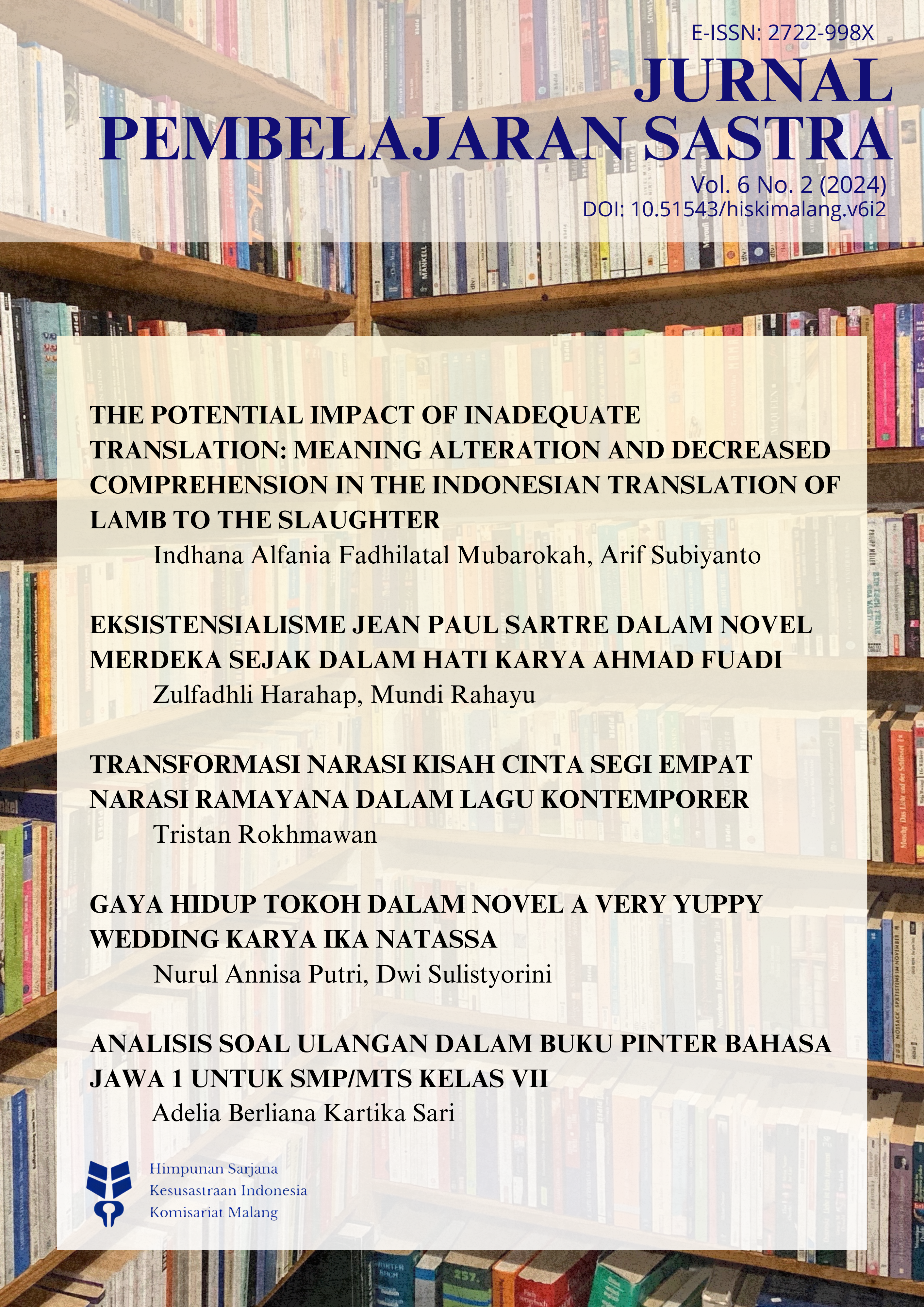THE POTENTIAL IMPACT OF INADEQUATE TRANSLATION: MEANING ALTERATION AND DECREASED COMPREHENSION IN THE INDONESIAN TRANSLATION OF LAMB TO THE SLAUGHTER
##plugins.themes.academic_pro.article.main##
Abstract
Translation is a complex art that plays a pivotal role in bridging cultures and facilitating the exchange of knowledge across languages. However, when translation falls short of exacting standards, it can alter meanings and affect reader comprehension. The author intended to suggest an alternative translation to the current online Indonesian translation of Roald Dahl’s short story Lamb to the Slaughter, and compare the results in the discussions. By analysing changes in word and phrase choices, this project reveals that inadequate translation can significantly alter the meaning of the story. This study analyzes the differences between two translated texts using Eugene Nida's equivalence theory. The project aims to understand how the principles of formal and dynamic equivalence are applied in the translation of Lamb to the Slaughter. The methodology employed is a comparative analysis of the two texts, focusing on language structure and fidelity to the original meaning. The findings indicate that translations using dynamic equivalence are more effective in conveying contextual meaning, while formal equivalence better preserves the original language structure.
##plugins.themes.academic_pro.article.details##

This work is licensed under a Creative Commons Attribution-NonCommercial-NoDerivatives 4.0 International License.
The Authors submitting a manuscript do so on the understanding that if accepted for publication, copyright of the article shall be assigned to Jurnal Pembelajaran Sastra (Journal of Literary Education) as publisher of the journal, and the author also holds the copyright without restriction.
Copyright encompasses exclusive rights to reproduce and deliver the article in all form and media, including reprints, photographs, microfilms and any other similar reproductions, as well as translations. The reproduction of any part of this journal, its storage in databases and its transmission by any form or media, such as electronic, electrostatic and mechanical copies, photocopies, recordings, magnetic media, etc. , are allowed with a written permission from Jurnal Pembelajaran Sastra (Journal of Literary Education).
Jurnal Pembelajaran Sastra (Journal of Literary Education), the Editors and the Advisory International Editorial Board make every effort to ensure that no wrong or misleading data, opinions or statements be published in the journal. In any way, the contents of the articles and advertisements published in the Jurnal Pembelajaran Sastra (Journal of Literary Education) are sole and exclusive responsibility of their respective authors and advertisers.
References
Bernthal, J. C. (2016). “And For a Knife We Shall Use the Great Sword”: Uncanny Cutlery and its Absence in the Fiction of Roald Dahl.”. FEAST Journal, 1(1).
Bilalia, P. (2019). PSYCHOLOGICAL ANALYSIS ON THE MAIN CHARACTER PERSONALITY IN THE SHORT STORIES BY ROALD DAHL. British (Jurnal Bahasa dan Sastra Inggris), 7(2), 99-109.
Burger, P. (2002). Contemporary legends in the short stories of Roald Dahl. Contemporary legend, 5, 136-158.
Dahl, Roald. (1953). Lamb to the Slaughter. Harper’s Magazine. https://harpers.org/archive/1953/09/lamb-to-the-slaughter/
CARÉ, S. C. V. (2021). FEMALE ANIMAL CHARACTERS IN ROALD DAHL’S CHILDREN’S BOOKS: A MISOGYNISTIC PORTRAYAL. Chakraborty, R. The fall of the angel, the rise of the monster: A feminist reading of Roald Dahl’s short story Lamb to the Slaughter. https://doi.org/10.22271/multi.2024.v6.i1a.359
Garini, H. B. A., & Winarti, W. (2021). THE REPRESENTATION OF WOMAN AS FEMME FATALE IN ROALD DAHL'S LAMB TO THE SLAUGHTER. FRASA: English Education and Literature Journal, 2(1), 15-21. Retrieved from https://ojs.udb.ac.id/index.php/FRASA/article/view/2043/1602
Herdy, Denny. (2017). Cerpen Tragedi Daging Kambing-Roald Dahl. Medium. https://medium.com/@dennyherdy/cerpen-tragedi-daging-kambing-roald-dahl-48bb56583ff8
Kałużna, A. (2019). Equivalence in students’ translation class. Explorations: A Journal of Language and Literature, (7), 121-130.
Kirana, F. D. (2023). KAJIAN STRUKTURALISME GENETIK: PANDANGAN DUNIA DALAM TIGA CERPEN PADA KUMPULAN CERPEN DECEPTION KARYA ROALD DAHL. Nusantara Hasana Journal, 3(3), 26-34.
Lai, K. L. (2020). Radical feminist theory on Roald Dahl’s lamb to the slaughter (Doctoral dissertation, UTAR). Retrieved from http://eprints.utar.edu.my/4152/
Nakashima, A. (2018). Reading Roald Dahl with Roald Dahl: Aspects of His Transformation. Hiroshima studies in English language and literature, 62, 109-109.
Negi, N., & Agarwal, N. Far from the Maddening Crowd: Exploring themes of Happiness and Conflict in the writings of Roald Dahl and Ruskin Bond. cenacle, 53.
Paramita, N. W. N. (2023). THE CHARACTERIZATION OF THE GRAND HIGH WITCH AS A LIBERAL FEMINIST IN ROALD DAHL’S THE WITCHES (Doctoral dissertation, Universitas Pendidikan Ganesha).
Prafitri, W., & Nasir, M. A. A. (2023). Messages Revealed Through Figurative Language Used in “Lamb to the Slaughter” by Roald Dahl. EBONY: Journal of English Language Teaching, Linguistics, and Literature, 3(2), 109-118. Retrieved from https://e-journal.upr.ac.id/index.php/ebony/article/view/8984
Scharnhorst, R. (2021). Teaching with Paratext: Rereading Roald Dahl’s Lamb to the Slaughter in the Literature Classroom. In CEA Forum (Vol. 49, No. 1, pp. 3-28). College English Association. Retrieved from http://www.cea-web.org
Sriastuti, A., & Kasih, E. N. E. W. (2022). the Unfulfilled Gender Stereotype in Lamb To the Slaughter By Roald Dahl. Linguistics and Literature Journal, 3(2), 159-163. Retrieved from http://jim.teknokrat.ac.id/index.php/linguistics_and_literature/index
Tanto, T. (2020). Roald Dahl's ingenious language play in the use of figurative language. International Journal of Humanity Studies (IJHS), 3(2), 201-210.
Tanusy, J. (2018, August). Feminism in Roald Dahl’s Lamb to the Slaughter: A Semiotic Analysis. In Fourth Prasasti International Seminar on Linguistics (Prasasti 2018) (pp. 159-163). Atlantis Press. Retrieved from https://www.atlantis-press.com/proceedings/prasasti-18/25899662
Tanusy, J. (2020). Racism in Roald Dahl’s The BFG: A Social Criticism or White Supremacy Tendency?. k@ ta, 22(2), 63-69.
Tumbole, G. F. F., & Cholsy, H. (2022). Strategi Penerjemahan Kata Sapaan dengan Konteks Sosial dan Budaya dalam Novel Bumi Manusia Terjemahan Bahasa Inggris. Diglosia: Jurnal Kajian Bahasa, Sastra, Dan Pengajarannya, 5(3), 589-602. Retrieved from https://diglosiaunmul.com/index.php/diglosia/article/view/432/202
Verzella, M. (2017). Making culture relevant in technical translation with dynamic equivalence: The case of bilingual instructions. Journal of Rhetoric, Professional Communication, and Globalization, 10(1), 4

